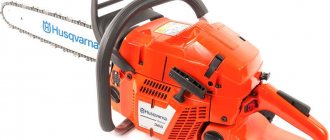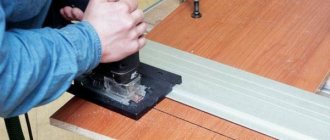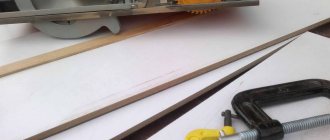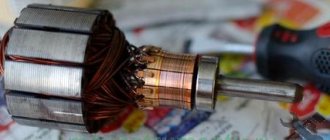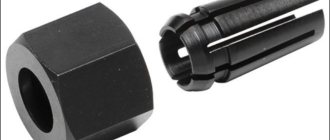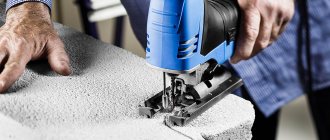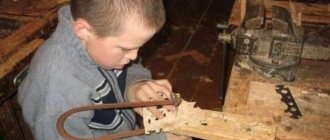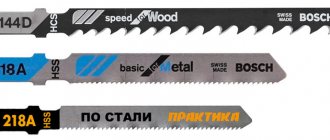Safety instructions when cutting with a jigsaw
INSTRUCTIONS No.
SAFETY WHEN CUTTING WITH A JIGSAW
It is allowed to work only with a working jigsaw that ensures reliable and correct fastening of the file.
The jigsaw handle should not have cracks or knots.
Sawing is performed on special tables. Tables must be level and smooth.
When sawing, a straight sitting posture is used.
The main danger when working with a jigsaw is injury to your hands as a result of the blade breaking. The file should be moved from top to bottom evenly, without distortions, with slight pressure on the metal.
Safety regulations
1. Work with a jigsaw and awl with securely fastened and working handles.
2. Securely attach the sawing table to the workbench.
3. Securely secure the file in the jigsaw frame.
4. Do not make sudden movements with a jigsaw when cutting, do not bend low over the workpiece.
Safety Basics:
Use a jigsaw and awl with securely fastened and working handles.
Securely attach the sawing table to the workbench.
Securely secure the file in the jigsaw frame.
Do not make sudden movements with the jigsaw when cutting, do not bend low over the workpiece.
1. When working with a jigsaw, you need to sit upright, half-sided towards the sawing table.
2. Securely attach the sawing table to the workbench.
3. Securely secure the file in the jigsaw frame.
4. Work with a jigsaw and awl with securely fastened and working handles.
5. When cutting, you should turn the plywood, not the jigsaw.
6. Do not make sudden movements with a jigsaw when cutting.
7. The file should be moved from top to bottom evenly, without distortions, with slight pressure.
8. Do not lean low over the workpiece.
- all materials
- Articles
- Scientific works
- Video lessons
- Presentations
- Notes
- Tests
- Work programs
- Other methodological materials
- Kireev Andrey PetrovichWrite 15242 09/20/2017
Material number: DB-696951
- Technology
- 5th grade
- Articles
- 20.09.2017 182
- 20.09.2017 184
- 20.09.2017 150
- 20.09.2017 365
- 20.09.2017 358
- 20.09.2017 609
- 20.09.2017 1765
- 20.09.2017 743
Didn't find what you were looking for?
You might be interested in these courses:
Leave your comment
Log in to ask questions.
Tyumen universities will take receipts from teachers if they refuse vaccination
Reading time: 1 minute
Russia has proposed issuing certificates to a number of schoolchildren for courses to prepare for the Unified State Exam
Reading time: 1 minute
Specialists in the field of pedagogy are in high demand in Russia
Reading time: 1 minute
The Russian Federation proposed introducing an education certificate for large families
Reading time: 1 minute
St. Petersburg schoolgirl scored 300 points on the Unified State Exam
Reading time: 1 minute
Participants will be able to take the Unified State Exam in six subjects during the reserve period of June 28
Reading time: 3 minutes
Gift certificates
Responsibility for resolving any controversial issues regarding the materials themselves and their contents is taken by the users who posted the material on the site. However, the site administration is ready to provide all possible support in resolving any issues related to the work and content of the site. If you notice that materials are being used illegally on this site, please notify the site administration using the feedback form.
All materials posted on the site were created by the authors of the site or posted by users of the site and are presented on the site for informational purposes only. Copyrights for materials belong to their legal authors. Partial or complete copying of site materials without written permission from the site administration is prohibited! The opinion of the administration may not coincide with the point of view of the authors.
Safety precautions when working with an electric jigsaw
Rice.
1. Jigsaw. It is necessary to distinguish the difference between work in production and in living conditions at home, the difference lies in the fact that in an enterprise for maintaining the health of an employee of the enterprise, specially appointed people are responsible - safety engineers, who for each type of work have drawn up a briefing outline which describes how to work with a tool. Special instructions are approved by the chief engineer and the head of the enterprise.
Types of instruction
The very first one, which is carried out upon entering a job, is an introductory one, which introduces the employee to the operating mode of the enterprise, compliance with personal hygiene conditions and daily routine, rights and responsibilities. The briefing is carried out against the signature of the instructed person in a special book.
The second is initial training at the workplace. This type includes specific labor safety requirements at the workplace where the future employee will perform tasks. This also includes electrical safety rules, fire safety, and evacuation rules.
The third is targeted training in safe work practices. The purpose of the briefing is to teach the employee how to work safely in the workplace. The instruction is conducted by an experienced master together with a mentor. After this, the student passes a skill test to an instructor or master, and with a positive assessment, he is allowed to work independently.
The fourth type of instruction is repeated; this type of instruction is carried out with employees to consolidate the skills and knowledge acquired during the initial instruction. Conducted once every 6 months.
The fifth was called unscheduled. It is carried out when legislative and legal acts are changed or put into effect that will affect the change in safety instructions, also if the enterprise has undergone a change in production technology, modernization or replacement of equipment.
Instructions and permission to work are recorded in special journals signed by the student employee.
Rice. 2. A visual poster on the types of instruction at the enterprise.
Sawing with a hand jigsaw (step by step instructions)
Any creative work, in any industry, requires certain knowledge and skills. If an author wants to create something truly valuable, his technique must be honed to the appropriate level. Working with a hand jigsaw can easily be classified as such an activity. In skillful hands, this seemingly simple device can create real works of art. Fortunately, it takes quite a bit of time to master figure sawing. All you need is a desire, and we will be happy to provide detailed instructions for action.
Maintenance and care of the jigsaw
Thanks to the successful design of modern jigsaws, you can forget about complex maintenance forever. The main thing is to clean it of sawdust and dust after completing the work, and lubricate the guide rollers about once a month. They do not affect the performance of the mechanisms in any way, but they have a direct impact on the quality of the cut.
If you follow these simple rules for operation and care, the jigsaw will serve its owner faithfully for many years, without a single failure.
Subscribe to our Yandex.Zen channel
You might be interested
- 12/28/2017 Bedroom furniture: what opportunities does the modern market offer?
- 05/19/2019 Products made from lilac wood
- 01/15/2020 Amazing decor ideas for a wooden home
- 01/16/2020 The Art of Nature (continued) – Alexander Cheglakov
- 05/03/2019 From an old bicycle tube to popsicle sticks. Helpful tips for working with wood
What material is best to work with?
The most suitable material for figured cutting is plywood, 3-10 mm thick. Durability and ease of cutting make it the best option for creating decorative elements with complex patterns. The average price of a sheet of plywood (1500x1500x6) is approximately 300 rubles, and you can find it at your nearest building materials store. Accessibility, aesthetics and ease of processing are the main qualities that the material used for figure sawing should have.
For cutting thin patterns, it is better to use thin, sanded plywood, 3-5 mm thick. Sawing such material is much easier, even for those who do not know how to use a hand jigsaw on wood, and the chance of damaging the product is significantly lower.
Another interesting material suitable for sawing with a hand jigsaw is sheet polystyrene (not to be confused with expanded polystyrene). It is essentially a durable plastic that comes in all colors and sizes. In order not to complicate manual sawing, it is better to work with sheets up to 5 mm thick. The beauty of polystyrene crafts is accompanied by the high price of the material (from 700 rubles per sq.m.) and limited availability. If you are confident in your cutting skills and are ready to create an original glossy craft, you can start your search at local construction markets.
How to apply a design to a workpiece
Not everyone, even a creative person, can boast brilliant artistic skills. For some, cutting with a hand jigsaw itself is a much simpler task than drawing the outline of a future craft. Fortunately, applying a pattern to a surface can be done in several basic ways that are accessible to almost everyone. Transfer the outline of the model using carbon paper. You can find one in office supplies, at an average price of 150 rubles for a pack of 50 sheets, which is enough for several hundred crafts.
Glue the patterned paper with double-sided tape or glue. In the second case, after cutting, the glued paper will have to be removed with sandpaper. Double-sided tape, can be carefully peeled off.
How to assemble a manual jigsaw
When the material has been selected and the contour to be cut has been drawn, you can begin assembling the working tool. First of all, we tighten the file in the lower fastening (at the handle), after which we thread the free end into the opposite groove and, slightly squeezing the frame, fix it in it. Be sure to remember that the teeth of the saw blade should always face the handle of the tool.
When compressing, do not put strong pressure on the frame, trying to bend the metal arc. It is enough for the fasteners to come closer to each other by about 1 cm. You can squeeze the metal frame in your hand, or by resting the tool with the handle on your chest. For devices with tubular arches, there are special devices with grooves. If you can’t tighten the lambs with your bare hand tightly enough, use pliers.
If the saw blade is installed correctly, it does not dangle, and during operation there is a high-pitched sound of teeth biting into the material. It is better to understand how to properly assemble a jigsaw from the very beginning, since thin files tend to burst. The easier the process of assembling the device is for you, the more enjoyable it will be to work.
How to cut correctly
Before moving on to the cutting technique, we should say a few words about the workplace. Of course, you can work by simply pressing the plywood to the edge of the table or your knee, but it will be more effective to use a simple device called a “dovetail” (not to be confused with the type of connection). It is a regular rectangular surface with a wedge-shaped cutout, where a round hole is located in place of an acute angle. You can easily make such a platform yourself or ask the store where you purchased the jigsaw. The device is attached to the table with a clamp and makes sawing with a hand jigsaw much easier.
During figure cutting, you will often encounter the same types of figures. Despite the fact that the technology for sawing with a hand jigsaw is quite simple, it will be useful to know a few nuances:
Safety precautions when working with a hand jigsaw
IV. Safety precautions
Routing
Morphological analysis of the product
Morphological analysis
III. Technological stage
To manufacture this product, it is necessary to analyze the component parts of the object and select the appropriate materials. To do this, we will use the method of morphological analysis.
| Signs | Alternative options | |||
| Material | plywood | Chipboard | wood | Fiberboard |
| Connection method | nails | screws | glue carpenter | grooves |
| Product finishing | varnishing | coloring | stain | drawing a picture with a burning device |
Of the listed construction materials, the most accessible in this case will be plywood, the use of which is economically beneficial for me; I have skills in processing technology; it guarantees the quality of the product in the final result; moreover, this material lends itself well to machining.
| № | Operation name | Sketch | Tools and accessories |
| 1. | Workpiece selection | Ruler, pencil | |
| 2. | Drawing a sketch on the workpiece | Copy paper, pencil | |
| 3. | Sawing out the outer contour | Jigsaw, stop (saw table) | |
| 4. | Drilling holes | Drill 3 mm, drilling machine | |
| 5. | Sawing out the inner contour | Jigsaw, stop (saw table) | |
| 6. | Face grinding | Sandpaper, drill press, sanding attachment | |
| 7. | End grinding | Sandpaper, needle files | |
| 8. | Sanding patterns | Files | |
| 9. | Product assembly | Carpenter's glue, wire for fastening elements | |
| 10. | Coating the product with stain | Stain "Larch", spray gun | |
| 11. | Varnishing | Varnish, brush | |
| 12. | Drying the product | ||
| 13. | Applying 2nd layer of varnish | Varnish, brush | |
| 14. | Drying the product |
· Check if there are any file residues in the clamps of the jigsaw frame.
· Fasten the file in the handle clamp so that the tops of the teeth of the file are directed towards the handle.
· Secure the opposite end of the saw blade to the top clamp of the jigsaw frame. The saw blade must be well tensioned, otherwise it may break when turning. When securing the upper part of the file, the jigsaw frame must be compressed. To do this, rest the upper part of the frame against the edge of the workbench lid and press the handle with your chest.
· Perform all work on cutting plywood while sitting at a cutting table. The file must move in a strictly vertical position and cutting must be done from top to bottom; the movement and movement of the file should be without jerking.
· While sawing, hold the workpiece with your left hand and use it to feed the workpiece along the marking line.
· Initially, all internal cuts were cut. To install the file in the internal cut, pre-drill or use an awl to pierce a through hole. Make the same hole in places where there are sharp turns. The outer diameter of the hole should easily touch the marking line so that the blade continues tangentially. When sawing internally, the upper part of the blade is passed through the hole and secured.
· Sawing is done on the right side of the marking. On sharp turns, turn the workpiece slowly, and move the jigsaw blade in the same rhythm (40-60 movements per minute).
· Straight cuts can be made with a hacksaw or bow saw. In this case, the saw should be held at a very small angle to the plane of the workpiece so that there are no chips of the plywood on the opposite side of the cut.
Your opinion is important to us! Was the published material useful? Yes | No
Instruction “Sawing with a hand jigsaw”
- Introduce students to the basic techniques of cutting with a hand jigsaw
Viewing the contents of the document “Instruction “Sawing with a manual jigsaw””
Public lesson. Sawing with a hand jigsaw.
Introduce students to the basic techniques of cutting with a hand jigsaw
To familiarize students with the methods of setting up and adjusting a jigsaw; teach how to carry out final processing of a product using sandpaper and a needle file.
Review occupational safety rules; cultivate thrift in the use of materials, accuracy and precision in work.
Tools and equipment:
carpenter's workbench, jigsaw, cutting equipment, clamp, blanks, needle file, sandpaper, copy paper, pencil, compass, awl, template, drawing.
for the teacher: projector, laptop, multimedia presentation “Sawing with a jigsaw”, samples of sawn products, lesson plan, cutting albums;
for students: jigsaw, files, plywood blank, sawing table, textbook notebook, sandpaper, files of different sections.
Chalkboard design:
topic of the lesson, new words, homework.
Object of work:
“Elephant”, “Parrot”, “Combined stand” - “Towards the Universiade 2013” (souvenirs)
organizational moment 1-2 minutes;
communicating the goals and objectives of the lesson to students 2-3 minutes;
communication of new material when viewing a multimedia presentation 7-10 minutes;
introductory briefing on safety and definition of the task 3-4 minutes;
independent work of students, ongoing instruction 20 min;
summing up, final briefing 4-5 min.
1. Introductory part.
At the beginning of the lesson, the teacher reminds students that straight cutting of wood can be done using a hand saw. After this, it is necessary to show beautiful products of complex shapes made with a jigsaw. Students examine the products (“Elephant”, “Parrot”, “Combined stand – “Towards the Universiade 2013”) and note their beauty. (slide No. 1)
The teacher and students recall where else they encountered products made with a jigsaw (platbands on a house in the village, household items, boxes, etc.) Then they are asked to pose the question: “How can this result be achieved?” “Which tool is best to use for the job?” “What devices should I use?”
2. Presentation of new program material.
Now let's start looking at the tool with which we will cut our products today. I am showing a sample. I disassemble and show individual parts).
The jigsaw consists of a handle, frame, upper and lower clamps and a file (5 frame of presentation).
Pay attention to the angle of the saw teeth. They should be tilted towards the handle, since when cutting the jigsaw is held vertically, which means cutting occurs when the jigsaw moves downwards.
Now, perhaps, the most difficult moment for you: installing the file. It can be tensioned by hand or using a cam clamp. We will install manually. To do this, you need to loosen the clamp on the jigsaw handle, insert the saw with the teeth tilted down and tighten the clamp nut. After this, you need to insert the file into the upper clamp, but before tightening it, you need to squeeze the jigsaw. The file must be installed with tension, otherwise it will not cut along the intended line, but will bend and break. Look how the file is tensioned (I show techniques for tensioning the file).
Let's try installing the saw. (Practical work of students on installing a saw). I go through the rows and check the correct installation and tension of the saw.
When cutting with a jigsaw, a special device is used to support the plywood - a sawing table (photo in the presentation). It is secured in a clamp. (demonstrating)
Types and mode of operation of files
The quality of work depends on the correctly selected cutting part for cutting various types of material. Files differ in shape and layout, have different heights and tooth directions. When choosing a jigsaw file, you must be guided by the following rules:
- For a straight cut, a saw blade is used, the blade of which is characterized as the widest. For a curved cut or a rounded cut, a file is used, the blade of which is characterized as medium.
- A clean, straight cut of wood material is performed using a standard saw, the teeth of which are of medium size and directed upward. The length of the file depends on the thickness of the material. If the quality of the cut does not matter, then for regular cutting you can turn on the pendulum movement, which will increase the speed of the jigsaw. For rough cutting of hard materials, it is recommended to use attachments with a wide blade and a large tooth.
- For rough cuts and uneven cuts, saw blades with large teeth are used. Cutting thick wood material should be done in two steps. When cutting, the tool should be held firmly, since when working with thick material, vibration and recoil increase as a result of the saw hitting the work surface.
- For cutting chipboard and laminated surfaces, it is recommended to use a saw with a reverse cut. This file does not leave chips on the front side of the material. If a fine-tooth attachment is used for cutting, the work must be performed strictly on the back side of the sawing material. Both methods can be performed at maximum tool speed.
- Straight cutting of metal is performed with a special file with a fine tooth. Externally, the cutting blade is similar to a standard hand hacksaw for metal. This type of saw is distinguished by the fact that it produces a clean cut without defects. However, when cutting other materials, the cutting speed is significantly reduced, which leads to rapid heating of the tool. Experienced craftsmen recommend using a sheet of plywood when cutting thin sheet metal. The plywood is placed on the work surface in advance, securely attached to the table, and thin sheet metal is laid on top of it. This cutting method will prevent tearing and deformation of the workpiece.
- Experts prefer to work with wood using a saw whose teeth are directed downward; such a file does not deform the surface of the sawn material. To avoid damaging the front side of the material surface, the cut should be made from the back side. Making a regular straight cut with a saw whose teeth point down requires experience, as there is increased kickback and high vibration during operation.
- For cutting tiles and ceramic tiles, a non-standard file is used, namely a file without teeth. Cutting tiles using a jigsaw is performed extremely rarely, due to the high consumption of material. Used only in cases where curved cuts are required.
- Plastic and plexiglass are sawed with a saw with small teeth downwards. The blade blade is medium. To perform an even cut, it is advisable to turn off the pendulum stroke. Cutting must be done at medium frequency. In order to avoid overheating of the saw and tool, it is necessary to use cooling. The speed should correspond to 30–40% of the maximum possible speed of the tool.
Despite the versatility of an electric jigsaw, experienced craftsmen recommend using other tools for cutting tiles and metal.
Having studied the basic cutting techniques using an electric jigsaw, it will not be difficult for a beginner to correctly cut not only various materials, but also cut straight, curved and shaped elements. By applying safety rules and cutting techniques, you can solve almost any cutting problem, regardless of the type of material and experience.
If an electric jigsaw is used for cutting plastic, plexiglass and wood materials, then the tool, with proper use and proper care, will last more than 5 years.
How to work with an electric jigsaw correctly - on wood, metal or chipboard
A jigsaw is a hand-held tool designed for cutting various materials at home. With its help you can get straight, round, oval, and curly cuts. Moreover, the tool is able to cope not only with wood, but also with materials of varying strength. However, in order to achieve an accurate cut, you need to know the features of preparing the tool for work, and how to use a jigsaw correctly. Otherwise, the final result will differ from the desired one.
To cut thin and thick materials you need different jigsaw files
GENERAL PROVISIONS
1.1. Employees who are at least 18 years old, have an electrical safety group of at least II, have undergone a preliminary medical examination, introductory and initial workplace safety briefings, have been trained in labor protection and electrical safety, have undergone on-the-job training, and tested their knowledge of the requirements are allowed to work with power tools. labor protection. 1.2. When working with power tools, an employee may be exposed to the following harmful and dangerous production factors: - increased levels of noise and vibration; — moving parts of equipment and tools, moving products, workpieces, materials; — flying particles, fragments of metal and abrasive materials; — increased dust content with metal and abrasive dust; — sharp edges, burrs, roughness on the surfaces of workpieces and waste; — insufficient illumination of the working area; — the possibility of exposure to electric current; - increased humidity in the workplace. 1.3. Personnel performing work with power tools must be instructed in accordance with the requirements of these instructions before starting work and then at least once every 3 months. 1.4. In case of failure to comply with the provisions of this instruction, employees may be subject to disciplinary, administrative, and financial liability in accordance with the legislation of the Russian Federation, depending on the severity of the consequences.
General cutting principles
It should be understood that a jigsaw produces an uneven cut. And to minimize the spread of the saw, you don’t need to make any special efforts when working with the tool. Simply press it to the surface of the material and set the direction of movement. The slower the cutting, the higher its quality.
Other general recommendations on how to use a jigsaw:
- During the cut, you need to constantly monitor the sharpness of the file and, if necessary, replace it in a timely manner. As soon as it becomes dull, the instrument begins to behave unpredictably.
- You should monitor the temperature of the cutting surface and avoid overheating. After all, this leads to rapid wear of the saw teeth.
- There are many types of jigsaw files. And each of them is designed for a specific type of material. To do quality work, you need to take this into account.
- Its functionality directly depends on the power of the tool. The higher this indicator, the more types of materials it can cut.
- Files with large teeth should be used for thick materials, and with small teeth - for thin materials.
- To get the most even seam, you should use additional devices such as a side stop, a jig, or a guide rail. This will allow you to move the tool through the material as smoothly as possible.
Important! As a guide when working with a jigsaw, you can choose any material with a smooth edge; the main thing is to align it correctly and secure the supporting end.
Principles of correct operation
After a jigsaw is purchased, the master must learn how to use it. A jigsaw is a simple tool. But even a hammer - which is easier - can be used in different ways.
There is a rule that knows no exceptions: there are no bad tools, only misused tools.
When using a jigsaw, the master has “three degrees of freedom.” The master must:
- Choose the right equipment (file).
- Set the optimal pumping amplitude and motor rotation speed.
- Use the most appropriate working methods.
We can talk about each point for a long time, but we will try to highlight the main points.
Selection of equipment
A great variety of files are produced and sold. They differ in the type of steel from which they are made, the length and width of the blade, the shape and size of the tooth:
- The harder the material that needs to be sawed, the smaller the tooth on the selected file should be.
- For a curved cut, you need to choose a narrow file. For straight cuts - as wide as possible.
- The length is selected based on the thickness of the workpiece that needs to be cut.
Read also: How to make inverter welding with your own hands
There are especially many different saws produced for working with wood. For quick cross cuts, choose a saw with large, set teeth. A large pitch allows you to cut very quickly, but it causes a lot of chips. For a clean cut, the tooth must be smaller.
Metal cutting files are very similar to a regular hacksaw blade for metal.
The files must be sharp. For important and large work, stock them in sufficient quantities.
Paging and speed
Pumping can significantly increase cutting speed. It is usually turned on when you need to quickly saw a large piece of wood straight. In other cases, it doesn’t really help and can even make work difficult or worsen the quality of the cut.
Figure cutting is done with paging completely disabled. It is impossible to give general recommendations here. You need to try different modes. The best solution is to first practice on some scraps of material.
Inexperienced craftsmen tend to work with a jigsaw immediately at maximum speed. It is not right.
When cutting plastics, the file can become very hot at high speed and the plastic will begin to melt. Not all metals like high speeds.
Start at low speed and increase it, carefully monitoring the result. If the quality of the cut deteriorates - the number of chips increases, the file overheats, etc. - reduce the speed of the file.
Working methods
As has been said many times, an electric jigsaw is a tool for many uses. However, the variety of situations comes down to just three cases: straight sawing, curved cutting and cutting holes.
Straight cut
This is the simplest case. Draw a line with a pencil and smoothly move the jigsaw along it. The built-in laser pointer will be more than useful here. Sometimes, for such work, a parallel stop, which is attached to the jigsaw frame, can be useful.
The saw blade speed can be set to maximum. Pumping will further increase cutting speed.
To maintain a straight line, you have to constantly “steer” the jigsaw. But even the most thorough “guidance” gives a mediocre result. In this type of work, a jigsaw is inferior to a circular saw in both cut quality and speed.
If straightness and evenness of the cut are critical to you, use a circular saw instead of a jigsaw.
Curvilinear cut
Such cuts are the native element of electric jigsaws. They were “born” for this.
The main secret of success is not to rush. Carefully mark the part. It is convenient to stick masking tape on the surface of the workpiece and draw lines with a pencil. Guide the jigsaw along the marking line, turning it slightly ahead. Small radius bends must be made especially slowly so that the forward movement for each saw stroke is minimal.
Cutting holes
This is one of those operations in which the jigsaw has no competitors. Typical examples: cutting a hole in a countertop to install a hob or sink, making a hole in a cabinet wall for an outlet, and thousands of other similar cases.
To cut a hole in a part, you first need to drill one or more “starter” holes using a drill. A jigsaw file is placed in them and the cut begins and ends in this hole.
If you have to cut a very large window, it is more convenient to cut it in parts.
Sawing at an angle to the surface of the part
All the cuts described above can be made not only perpendicular to the surface, but also at an arbitrary angle up to 45 degrees to the plane of the part. The need for such cuts arises, for example, if you need to connect two parts “on the mustache”.
Features of preparing a jigsaw for work
At the stage of preparing the tool for work, you need to inspect it for damage and check the integrity of the power cable. You also need to immediately prepare all the files that may be needed to complete the task and set up the appropriate modes.
Before cutting, mark the material.
When purchasing, it is better to choose a tool equipped with a laser guide.
How to work with a jigsaw: features and rules
Depending on the type of material, the rules for making a cut are slightly different. And to avoid mistakes, you need to familiarize yourself with how to work with a jigsaw in a given case.
How to cut metal
When cutting metal, you should use a fine-toothed file. For thin and soft materials such as copper, aluminum, the speed can be set higher. A level above 750 W is considered optimal. And to reduce the friction force, you should periodically drip oil during operation.
Important! When cutting sheet metal, it is better to place plywood under it, which will reduce vibration.
How to cut wood, chipboard, plywood
The largest range of files is presented specifically for cutting these materials. But they must be used for their intended purpose. The number of strokes should be set based on the maximum values of the tool.
To make a cut in this case, you will need files with large teeth from 2 to 6 mm. The more complex the type of work, the smaller their size. A straight cut can be made at high speeds, and with a curly cut, the rotation speed can be reduced.
Having mastered the basic principles of how to properly work with an electric jigsaw on wood, plywood and chipboard, not only an adult, but also a child will be able to cope with such a task.
How to cut metal tiles
In this case, the greatest difficulty is the metal tile profile. And, in order to make the cut correctly, it is recommended to secure a sheet of material between the bars on both sides. This will eliminate vibration and create a certain gap for comfortable work.
Important! In order not to spoil the metal tile coating during the cut, you need to wrap the sole of the tool with a cloth.
How to cut plexiglass, plastic
For cutting this material, the same files as for metal are suitable. The pendulum stroke should be set to the minimum position or turned off completely. Plastic and plexiglass need to be processed at minimum speed.
Electric jigsaw technology
Using a jigsaw, you can cut through various materials without much effort. But still, the quality of work requires a special approach to each type of canvas.
Selection and preparation of material sheet
A jigsaw can be used to cut blades of varying densities. The material for cutting can be wood products, plastic or tiles. You can also cut metal using a power tool.
Workpieces for sawing must have a homogeneous structure. If wood panels are used, the presence of knots or metal elements such as staples, nails or screws should be excluded. Wood blanks are used for cutting only in dried form. To cut out a design, it is recommended to select a material with a flat surface.
The canvas selected for processing is fixed in a horizontal position. Cutting lines are drawn on its surface using a pencil.
Cutting down a tree
To work with wood materials, special files with fairly large teeth are installed in the tool - from 2 to 6 millimeters. The more complex the shape of the cut, the smaller their size should be.
Straight cutting of wooden panels can be carried out at the highest speeds. For more precise cutting of products, the rotation speed of the cutting element can be reduced.
To work with wood, you will need files with large teeth.
To increase the speed of material processing, it is recommended to turn on the pendulum stroke. It is used if the quality of the cut is not particularly important.
You should cut smoothly without much effort. During operation, the tool must be pressed evenly against the surface of the workpiece.
Metal processing
In this case, the cutting blade should have small teeth, the distance between which does not exceed 1-2 millimeters. During the process of sawing metal blades, the pendulum stroke is completely switched off. Material processing is performed at the lowest speed.
Read also: How a smoke generator for cold smoking works
You need to move the jigsaw very slowly, avoiding any pressure on the tool. Before processing, the material is fixed so that the cut line is as close as possible to the support.
We cut plastic
A cutting blade for plastic workpieces is no different from a saw for metal. During the sawing process, the minimum position of the pendulum stroke is established. For smoother cuts, turn it off completely.
Plastic processing is performed at low speeds. The tool is pressed tightly against the blade and moves smoothly along its surface.
Sawing tiles
Such products require a special file with abrasive material applied in place of the teeth. In this case, the pendulum stroke is not used. The entire work process is carried out at the maximum set speed.
Cutting tiles with an electric jigsaw is used only when small cuts are necessary. This is due to the fact that saws deteriorate quickly and require frequent replacement.
Features of cutting straight elements
This type of work with a jigsaw does not require complex manipulations. It is enough to make a marking and smoothly move the tool along it. But you can also make the process easier by using special devices.
Sawing with a guide bar
This metal ruler has a groove, which is necessary for installing a special jigsaw sole and can greatly simplify the work. When using a guide bar, you first need to make a marking and then fix it. In this case, the jigsaw moves along the device and makes an even cut.
Using the rip fence
All models of jigsaws from Bosch, Interskol and other manufacturers have a hole in the sole for a rip fence bar. This device ensures an even cut of various materials. But when using it, you need to press the jigsaw tightly onto an absolutely flat surface.
Important! It is not recommended to install a parallel stop on parts that will move to the side when cutting.
In most cases, a parallel stop is included with the tool.
Rules for using a jigsaw
An electric jigsaw is widely used for straight and curved cuts. Used for cutting laminate, parquet boards, chipboard, plastic, plexiglass, metal, tiles and ceramic tiles. The quality of the cut depends not only on the experience of the master, but also on the technique. Sawing activities should be carried out on a special sawing and cutting table, which can be built independently or purchased ready-made in specialized stores. The workplace should have fairly good lighting.
To cut freely with a jigsaw, you need to install the tool so that its cutting part is in contact with the surface of the material. After turning on the jigsaw, the file must be moved smoothly, without force or pressure along the marking.
To cut parallel to the edge, use a guide bar, which is installed against the edge. When cutting, the tool skid must always be parallel to the tire.
Bevel cutting is done using a tool skid, which is set at the desired angle. To make a bevel cut, the ski screws must be slightly loosened and set at an angle, after which they should be tightened well and the cut begins. For beginners, it is recommended to cut at an angle using a guide rail or ruler.
To cut out an oval and a circle, a persistent compass is used, which is installed in the center on the working surface. The cutting procedure begins from the edge, then you should smoothly move the jigsaw along the markings.
You can cut oval or round holes using a circle cutter. First you need to drill a hole, the diameter of which should be 2 cm larger than the width of the working file. Then you need to install the circle cutter, then install the file in the hole and start sawing. The circle cutter in this case will serve as a compass.
It is recommended to make longitudinal cuts using a metal support bar, which serves as a limiter. One side of the support bar will always move along the face of the work material. Cutting at an angle should be done extremely carefully. It is recommended to set the support sole to a certain degree.
To improve the movement of the tool along the working surface, it is better to use a special metal pad for the support leg.
Sawing with a saw table
This design allows you to significantly simplify the process of cutting different materials. When using, you need to move not the tool, but the workpiece. This allows you to control the marking line without much difficulty. But at the same time, increased forces on the surface being processed should be avoided.
You can buy a saw table or assemble it yourself
The most common breakdowns, how to avoid them and safety precautions
High-quality jigsaws such as Bosch, Vortex, Zubr have a long service life. But even these tools can break down from time to time.
- If metal dust gets into the case, the start button may stop working. In this case, it should be cleaned with a special vacuum cleaner and, if necessary, replaced.
- The tool rod often fails because it is subjected to increased mechanical stress. As a result, a breakdown occurs and the fixing device connected to it deteriorates. This occurs when dust and particles of various materials get inside the housing. Good quality jigsaws do not have such problems.
- Engine stops often occur as a result of burnout of the stator, rotor, or wear of a notch on the shaft. In this case, the parts must be replaced.
Important! When performing various types of work, the power of the jigsaw should be taken into account.
The most common breakdowns and methods for their prevention
High-quality jigsaws have a fairly long service life. But even the best models can suddenly fail. The most common tool parts that fail are:
- Start button. Basically, such a design element stops working when metal dust gets into the housing. To eliminate the problem, you need to perform simple cleaning using a special vacuum cleaner. With prolonged use of an electric jigsaw, the button fails as the mechanism wears out.
- Mechanical connections. Most often the rod gets damaged. This element is most affected by mechanical loads. The locking device, which is connected to the rod, often fails. This is all due to dust getting inside the housing while cutting various materials. But if the instrument has a high-quality body, then such problems practically do not arise.
- Engine. Stopping the electric driving mechanism can occur when the stator or rotor burns out. Also, sometimes the problem occurs due to wear on the notch on the shaft. In order for an electrical device to work long enough, its power should always be taken into account before setting certain tasks.
Jigsaw safety and maintenance
Safety precautions must be followed when using this tool. It is important not only to know how to sit correctly when working with a jigsaw, but also how to hold it so as not to cause injury.
- sit upright, half sideways to the cutting table;
- securely fasten the file;
- Make the cut on a flat surface after fixing;
- cut at a distance of 40 cm from the eyes;
- use special glasses;
- securely secure the handle of the tool so that it does not slip.
Knowing how to use a jigsaw correctly, you can cut any material without much difficulty. Indeed, unlike hand tools, it is able to cope with the task much faster. The main thing is to follow the instructions included with the jigsaw in order to correctly calculate the load and avoid injuries.
Safety regulations
Safety rules must be followed not only by beginners, but also by experienced professionals. Compliance with safety precautions will not only prevent injuries, but also facilitate the work process, as well as increase productivity and quality of work.
- Working with a jigsaw begins with a careful inspection of the tool to ensure the serviceability of the tool and the integrity of the power cable.
- Do not touch a moving part of the tool with your hands in an attempt to check its rigidity and tightness of installation while the power cord is plugged in.
- Work should be done with gloves and safety glasses.
- It is prohibited to carry out sawing work while intoxicated.
- All work with an electric jigsaw must be performed in a dry room.
- Before cutting, the working material should be securely fixed on the workbench. The immobility of the material will increase productivity and improve the quality of the cut.
- During the cutting process, no effort should be made to increase the speed. By pushing the tool forward, you risk breaking the saw, and this can cause irreparable damage to your health. During the cutting process, the tool itself must pave the way, smoothly moving forward. The master’s task is to set and maintain the desired direction.
- It is forbidden to use a dull file for cutting. A file with dull teeth reduces the cutting speed and deforms the front and back surfaces of the material. Moreover, a dull file increases the load on the electric drive, which leads to premature failure of the tool.
- Upon completion of work, the tool must be thoroughly cleaned and blown with air. It is recommended to store the tool in a dry place.
Compliance with the above rules will help to avoid injuries when working with an electric jigsaw and will increase the service life of the tool.
